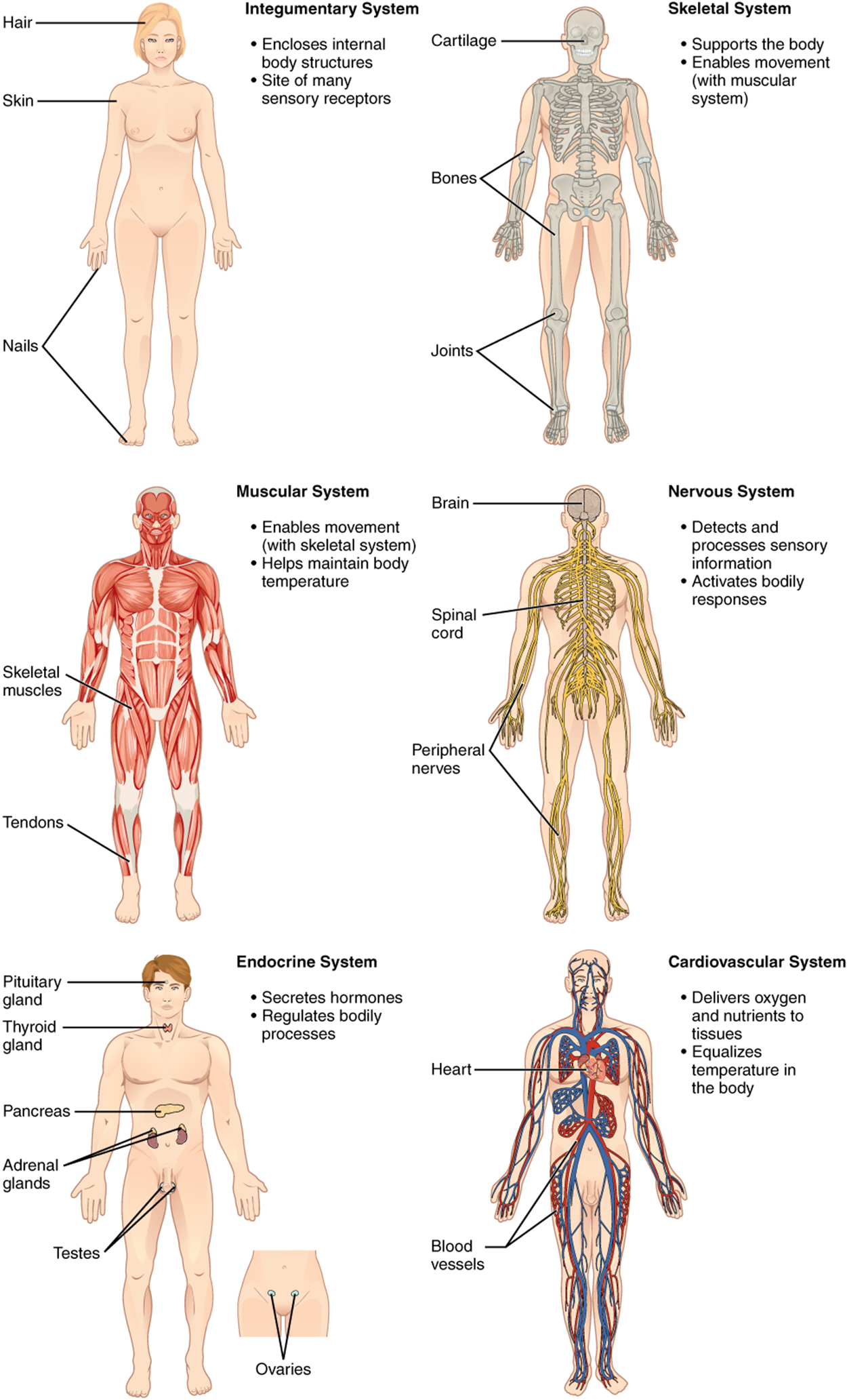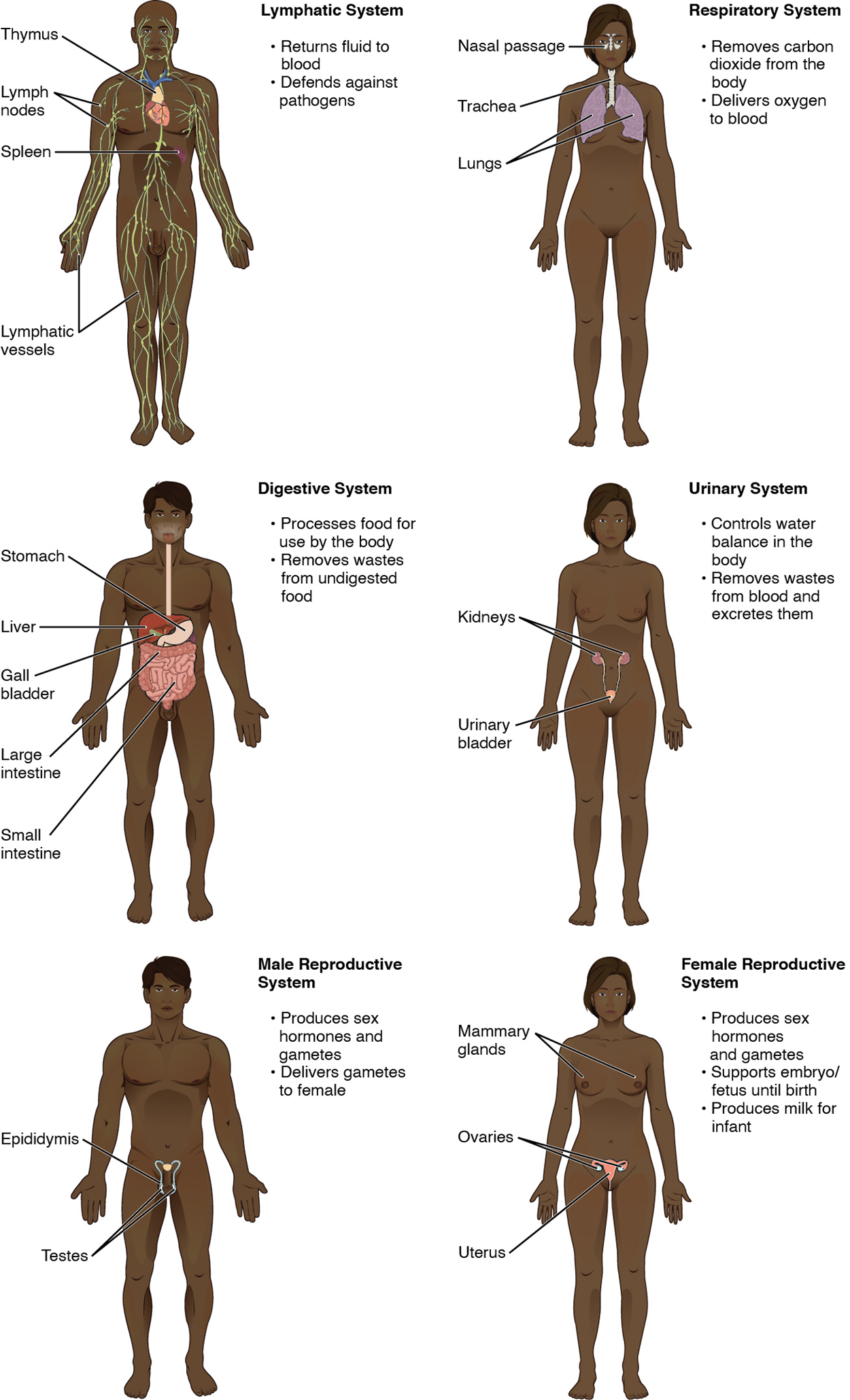Table of Contents |
Anatomy & physiology covers eleven distinct organ systems in the human body. Assigning organs to organ systems can be imprecise since organs that “belong” to one system can also have functions integral to another system. In fact, most organs contribute to more than one system.
| Organ System | Primary Function(s) | Primary Organ(s) | Course That Details Are Taught |
|---|---|---|---|
| Integumentary System |
|
Skin | A&P I |
| Skeletal System |
|
Bones | A&P I |
| Muscular System |
|
Muscles | A&P I |
| Nervous System |
|
Brain, spinal cord, nerves | A&P I |
| Endocrine System |
|
Pituitary Adrenal Glands Thyroid |
A&P II |
| Cardiovascular System |
|
Blood Heart Blood vessels |
A&P II |
| Lymphatic System |
|
Lymph nodes Lymphatic vessels Spleen |
A&P II |
| Respiratory System |
|
Lungs | A&P II |
| Digestive System |
|
Esophagus Stomach Small & large intestine |
A&P II |
| Urinary |
|
Kidneys Urinary bladder |
A&P II |
| Reproductive |
|
Testes, penis Ovaries, uterus, vagina | A&P II |


| Organ System | How They are Named |
|---|---|
| Integumentary System | The word integument, from the Latin root, means to cover. The primary organ of this system is the skin which functions to cover the body. Therefore, the name for this system is a fancy way of saying the ‘covering’ system. |
| Skeletal System | The primary organs of this system are the bones that form the skeleton. Therefore, this is the system related to the skeleton. |
| Muscular System | The primary organs of the muscular system are muscles attached to the skeleton. Therefore, this is the system related to the muscles. |
| Nervous System | The primary structures of the nervous system - brain, spinal cord, and nerves - are all composed of nervous tissue. Therefore, this is the system made of nervous tissue. |
| Endocrine System | From the Greek and Latin roots, ‘endo’ means inside and ‘crine’ means to secrete. The primary function of this system is to produce and release hormones (chemical signals) inside the body. Therefore, the name for this system is a fancy way of saying ‘internally secreting’ system. |
| Cardiovascular System | From the Greek and Latin roots, ‘cardio’ means heart and ‘vascular’ means vessel. The primary structures of this system are the heart and blood vessels. Therefore, the name for this system is a fancy way of saying the ‘heart and blood vessel’ system. |
| Lymphatic System | From the Latin root, ‘lymph’ means a colorless fluid. Where the cardiovascular system contains blood, the lymphatic system contains a similar but colorless fluid called lymph. Therefore, this is the organ system related to lymph. |
| Respiratory System | From the Latin root, ‘respire’ means to breathe again. The primary function of this system is to exchange gasses between the body and the air which is only accomplished by breathing. Therefore, the name for this system is a fancy way of saying the ‘breathing’ system. |
| Digestive System | From the Latin root, ‘digest’ means to separate, divide, or carry apart. A primary function of the digestive system is to break apart food that has been consumed. Therefore, the name for this system is a fancy way of saying the ‘breaking down’ system. |
| Urinary System | The primary function of the urinary system is to produce urine (i.e., pee). Therefore, this is the system that produces urine. |
| Reproductive System | From the Latin root, ‘reproduce’ means to develop or create a copy again. The primary function of this system is to produce sex-specific cells and, through their union, develop offspring (i.e., babies). Therefore this is the offspring development system. |
Source: THIS TUTORIAL HAS BEEN ADAPTED FROM OPENSTAX “ANATOMY AND PHYSIOLOGY 2E.” ACCESS FOR FREE AT HTTPS://OPENSTAX.ORG/DETAILS/BOOKS/ANATOMY-AND-PHYSIOLOGY-2E. LICENSE: CC ATTRIBUTION 4.0 INTERNATIONAL.